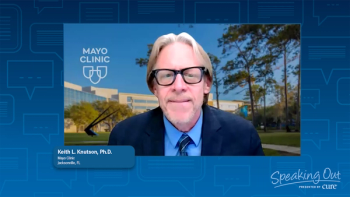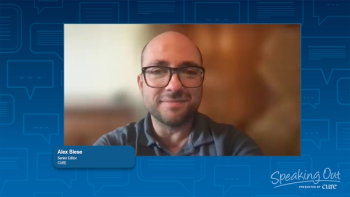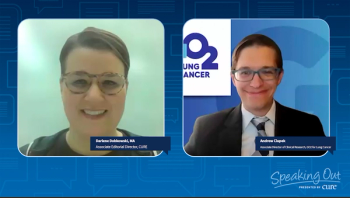
Raising Awareness About Gastric Cancer in Young Adults
Sam Klempner, M.D., of Massachusetts General Hospital, highlights common symptoms that may prompt an evaluation for gastric cancer in young adults and explains why patients and health care professionals need further education on the management of the disease.
Kristie Kahl: Hi, my name is Kristie Kahl, vice president of content at MJH Life Sciences™, the parent company of CURE® magazine. In this edition of the “Speaking Out” video series, on behalf of Hope For Stomach Cancer, we are speaking with Dr. Sam Klempner from Massachusetts General Hospital about raising awareness of gastric cancer in young adults. Hi, and welcome.
Sam Klempner, M.D.: Hey, thanks for having me.
Kristie Kahl: Thank you. To start, what are the signs and symptoms of gastric cancer?
Sam Klempner, M.D.: This is a tough one. The signs and symptoms are unfortunately often very nonspecific. They commonly include things like unintentional weight loss; feeling full very quickly, which we call early satiety; sometimes difficulty getting food down, so [you] feel like food is getting stuck. And of course, abdominal pain, which can be caused by multiple things, but a persistent abdominal discomfort that hasn’t responded to other therapies is always a warning sign.
Kristie Kahl: Are there risk factors you can discuss that are associated with the disease?
Sam Klempner, M.D.: We definitely know something about risk factors that lead to an increased chance of getting gastric cancer or even a lower esophageal cancer. Particularly [Helicobacter] pylori, which is a very common bacteria and ultimately leads to a chronic inflammation in the stomach, which drives the risk of gastric cancer. [H. pylori] probably accounts for a lot of stomach cancer risk around the world. There are other things that are lesser factors. Of course, things like prior radiation, prior gastric surgeries, smoking, alcohol. Then there are some dietary risk factors that seem to appear in some larger studies, although none of that is clearly established. Primarily, it’s the H. pylori bacteria that we all need to remember.
Kristie Kahl: Can you explain how stomach cancer is diagnosed?
Sam Klempner, M.D.: The most common situation is based on clinical symptoms. Oftentimes, patients will have symptoms for some time. They will be thought of as other things initially, because gastric cancer may not be the first thing that comes to mind when you go see your primary care doctor. But if you are not responding to the things people are trying to do and the symptoms persist, then we need to think about other causes. It’s usually diagnosed based on symptoms. Ultimately, people will be referred for an endoscopy, a camera down the throat, to look at the lining of the stomach where they may see an abnormality that they will biopsy. That’s what confirms the diagnosis. Sometime the symptoms are bad enough where people may present to the emergency [department] and undergo a CT scan, and this could be a finding seen on CT. But it’s quite sad that a lot of our patients are not diagnosed until they are at a relatively advanced stage because when they have symptoms, the cancer has been there for some time and had the chance to move to other places. In other countries where stomach cancer may be more common, there are some screenings where patients at the age of 40 will get an upper endoscopy to look for gastric cancer. In those places, we diagnose patients substantially earlier.
Kristie Kahl: How is gastric cancer staged? How does that determine treatment options?
Sam Klempner, M.D.: Staging is what I consider one of the most important parts of our jobs as oncologists because we are asking the question, is the stomach cancer localized to only the stomach and the lymph nodes right next to it, or has it spread to other locations? This, of course, informs the treatment goal and also the treatment approach. The standard way to stage a stomach cancer is you need a biopsy to confirm and look under the microscope. That’s still the standard. That’s generally done by an upper endoscopy, a camera down the throat, to get a small piece. But if there are tumor locations in other places, it can sometimes be done with a biopsy of another location as well. Then you need a staging scan. This is usually a CT [computed tomography] scan plus or minus a PET [positron emission tomography]/CT. This is looking for disease that has spread to other places, like the lymph nodes, as well as metastatic disease. The liver, lungs and abdominal lining are some of the more common locations. Then, we as a team put all that information together, and we come up with what we call the stage. It’s a combination of imaging, biopsy, and upper endoscopy [that] are the main tools to come up with a stage.
Kristie Kahl: When it comes to education, why is it important for health care providers, and even further for patients, to be educated about gastric cancer?
Sam Klempner, M.D.: I think a lot of the power should be in the hands of the patients. It’s education and understanding of symptoms. The majority of the time, if you are young when you have a symptom, it’s not cancer. It’s muscle strain, or a viral infection, or whatever. But if you have a symptom that is not going away, that should be a warning sign that it may require a little more work-up. Sometimes we’ll also see tumors [that] bleed. And darkening of the stool, or blood in the stool, is always a warning sign. It’s never really normal. But really, understanding and educating, and getting the early warning signs out there, are one of the ways we hope to move some of the diagnoses earlier, where we can cure many more patients. A lot of our job is educating patients. Then they may pass on some of this information to families. Ultimately, we hope it may result in earlier diagnosis and more cures.
Kristie Kahl: Dr. Klempner, are there resources you can recommend for patients to learn more about gastric cancer?
Sam Klempner, M.D.: There are some really good resources out there. Of course, as someone on the treatment team, we like to think of ourselves as great resources. Patients can always reach out to us and other members of our multidisciplinary teams. But there is a lot of learning that happens independent of the appointments. Some of the nonprofit [organizations] that are focused on gastric cancer, like Hope for Stomach Cancer, offer really good direction, whether it be about treatment, support, nutrition. Some of the mentorship pairings I think are very important, and patients learn well from each other. Then national guideline committees, the NCCN [National Comprehensive Cancer Network], for example. The National Comprehensive Cancer Network has a good guideline for patients that includes a lot of questions to ask your treatment team so that you ensure you are getting all the right care. We try to give both resources and point to these nonprofits for all new patients. Because unfortunately, we just don’t have time to spend an hour talking about education, which is really important. The more educated patients are about their own cancer, the better advocates they can be for themselves and people they are caring for. Yes, there are some good resources out there.
Kristie Kahl: Thank you so much.
Sam Klempner, M.D.: Of course. Thanks for having me.
Transcript edited for clarity.





